Waste Heat Recovery from Air Using Porous Media and Conversion to Electricity
Abstract
:1. Introduction
2. Materials and Methods
2.1. Description of the System
2.2. Mathematical Model
2.2.1. Ideal Gas Law
2.2.2. Continuity Equation
2.2.3. Equation of Motion
2.2.4. Energy Equations
2.2.5. Physical Properties
2.2.6. Thermoelectric Generation
2.3. Boundary Conditions
2.4. Simulation Conditions and Parameters
2.5. Numerical Grid Independence Test
2.6. Numerical Method
3. Results and Discussion
4. Conclusions
Author Contributions
Funding
Institutional Review Board Statement
Informed Consent Statement
Data Availability Statement
Acknowledgments
Conflicts of Interest
Nomenclature
| a | Specific area (1/m) |
| C2 | Coefficient of inertial resistance (1/m) |
| Cp | Heat capacity (J/kg K) |
| D | Duct side (m) |
| D | Electric flux density (C/m2) |
| dp | Particle diameter (m) |
| E | Electric field strength (V/m) |
| g | Gravity acceleration (m/s2) |
| h | Heat transfer coefficient (W/m2 K) |
| I | Electric current intensity (A) |
| J | Electric current density (A/m2) |
| K | Permeability of the porous media (m2) |
| L | Duct length (m) |
| Weighted molar mass of the gaseous mixture (kg/kmol) | |
| m | Mass flow (kg/s) |
| Number of thermoelectric elements. | |
| p | Pressure (Pa) |
| P | Electrical power (W) |
| Prandtl number | |
| Q | Heat flux given up in the central region of the duct (W) |
| Heat flux vector (W/m2) | |
| Heat generated per unit volume (W/m3) | |
| Universal gas constant (Pa m3/Kmol K) | |
| Ratio of external electrical resistance to total internal resistance | |
| Particle Reynolds number | |
| Electrical resistance (Ω) | |
| Temperature (K) | |
| Source term | |
| Time (s) | |
| Gas velocity (m/s) | |
| Greek Letters | |
| Absolute Seebeck coefficient (V/K) | |
| Diffusion tensor for arbitrary scalar | |
| Overall system efficiency | |
| Thermal conductivity, (W/m k) | |
| Dynamic Viscosity (Pa s) | |
| Permittivity tensor, (F/m) | |
| Peltier coefficient (W/A) | |
| Density (kg/m3) | |
| Electrical conductivity (1/Ω m) | |
| Reynolds stress tensor (Pa) | |
| φ | Generic scalar |
| ϕ | Porosity |
| ψ | Voltage (V) |
| Sub-indexes | |
| 0 | Inlet |
| ∞ | Relative to bulk |
| C | Centre |
| ce | Relative to ceramic material |
| cu | Relative to copper material |
| D | Darcy |
| E | Relative to electrical conductors |
| f | Relative to fluid phase |
| i | Interfacial or internal |
| L | Outlet |
| max | Maximum |
| min | Minimum |
| n | Relative to the n-type semiconductor |
| o | External |
| norm | Normalised variable |
| p | Relative to the p-type semiconductor |
| R | Right |
| s | Relative to solid phase |
References
- World Energy Outlook 2019. Available online: https://iea.blob.core.windows.net/assets/98909c1b-aabc-4797-9926-35307b418cdb/WEO2019-free.pdf (accessed on 1 October 2021).
- Johnson, I.; Choate, W.T.; Davidson, A. Waste Heat Recovery Technology and Opportunities in U.S. Industry; EERE: Washington, DC, USA, 2008; pp. 10–13. [Google Scholar] [CrossRef]
- Johansson, M.; Söderström, M. Electricity generation from low temperature industrial excess heat an opportunity for the steel industry. Energy Effic. 2014, 7, 203–215. [Google Scholar] [CrossRef] [Green Version]
- Zhang, H.; Wang, H.; Zhu, X.; Qiu, Y.J.; Li, K.; Chen, R.; Liao, Q. A review of waste heat recovery technologies towards molten slag in steel industry. Appl. Energy 2013, 112, 956–966. [Google Scholar] [CrossRef]
- Miró, L.; Bruckner, S.; Cabeza, L. Mapping and discussing industrial waste heat (iwh) potentials for different countries. Renew. Sustain. Energy Rev. 2015, 51, 847–855. [Google Scholar] [CrossRef] [Green Version]
- Papapetrou, M.; Kosmadakis, G.; Cipollina, A.; La Commare, U.; Micale, G. Estimation of the technically available resource in the EU per industrial sector, temperature level and country. Appl. Therm. Eng. 2018, 138, 207–216. [Google Scholar] [CrossRef]
- Gou, X.; Xiao, H.; Yang, S. Modeling, experimental study and optimization on low-temperature waste heat thermoelectric generator system. Appl. Energy 2010, 87, 3131–3136. [Google Scholar] [CrossRef]
- Ismail, B.I.; Ahmed, W.H. Thermoelectric power generation using waste heat energy as an alternative green technology. Recent Pat. Eng. 2009, 2, 27–28. [Google Scholar] [CrossRef]
- Mamur, H.; Ahiska, R. A review: Thermoelectric generators in renewable energy. Int. J. Renew. Energy Res. 2014, 4, 128–136. [Google Scholar]
- Niu, X.; Yu, J.; Wang, S. Experimental study on low-temperature waste heat thermoelectric generator. Power Sources 2009, 188, 621–626. [Google Scholar] [CrossRef]
- Liu, C.; Chen, P.; Li, K. A 1 KW thermoelectric generator for low-temperature geothermal resources. Trans.-Geotherm. Resour. Counc. 2014, 38, 749–754. [Google Scholar]
- Arsie, I.; Cricchio, A.; Pianese, C.; Ricciardi, V.; De Cesare, M. Modeling analysis of waste heat recovery via thermo-electric generator and electric turbo-compound for co2 reduction in automotive si engines. Energy Procedia 2015, 82, 81–88. [Google Scholar] [CrossRef] [Green Version]
- Crane, D.; Jackson, G. Optimization of cross flow heat exchangers for thermoelectric waste heat recovery. Energy Convers. Manag. 2004, 45, 1565–1582. [Google Scholar] [CrossRef]
- Hendrick, T.; Choate, W. Engineering Scoping Study of Thermoelectric Generator Systems for Industrial Waste Heat Recovery; EERE: Washington, DC, USA, 2006; pp. 4–22. [Google Scholar] [CrossRef] [Green Version]
- Gao, W.; Hodgson; Kong, L. Numerical analysis of heat transfer and the optimization of regenerators. Numer. Heat Transf. A 2006, 50, 63–65. [Google Scholar] [CrossRef]
- Amiri, L.; Ghoreshi Madiseh, S.A.; Ferri, H.; Sasmit, A.P. A porous media based heat transfer and fluid flow model for thermal energy storage in packed rock bed. In Proceedings of the International Conference on Sustainable Energy and Green Technology, Kuala Lumpur, Malaysia, 20–22 August 2019; Volume 268. [Google Scholar] [CrossRef]
- Pavel, B.I.; Mohamad, A.A. An experimental and numerical study on heat transfer enhancement for gas heat exchangers fitted with porous media. Int. J. Heat Mass. Transf. 2004, 47, 4439–4952. [Google Scholar] [CrossRef]
- Hsu, C.; Huang, G.; Chu, H.; Yu, B.; Yao, D. Experiments and simulations on low-temperature waste heat harvesting system by thermoelectric power generators. Appl. Energy 2011, 88, 1291–1297. [Google Scholar] [CrossRef]
- Rowe, D. Thermoelectric waste heat recovery as a renewable energy source. Int. J. Innov. Energy Syst. Power 2006, 1, 13–23. [Google Scholar]
- Tang, Z.; Deng, Y.; Su, C.; Shuai, W.; Xie, C. A research on thermoelectric generator’s electrical performance under temperature mismatch conditions for automotive waste heat recovery system. Case Stud. Therm. Eng. 2015, 5, 143–150. [Google Scholar] [CrossRef] [Green Version]
- Orr, B.; Akbarzadeh, A.; Mochizuki, M.; Singh, R. A review of car waste heat recovery systems utilizing thermoelectric generators and heat pipes. Appl. Therm. Eng. 2016, 101, 490495. [Google Scholar] [CrossRef]
- Uyanık, T.; Ejder, E.; Arslanoğlu, Y.; Yalman, Y.; Terriche, Y.; Su, C.-L.; Guerrero, J.M. Thermoelectric Generators as an Alternative Energy Source in Shipboard Microgrids. Energies 2022, 15, 4248. [Google Scholar] [CrossRef]
- Donoso-García, P.; Henríquez-Vargas, L. Numerical study of a waste heat recovery thermogenerator system. J. Braz. Soc. Mech. Sci. Eng. 2019, 41, 356–364. [Google Scholar] [CrossRef]
- Henríquez-Vargas, L.; Donoso-García, P. Numerical study of thermoelectric generation within a reciprocal flow porous media burner. J. Mech. Eng. Autom. 2013, 3, 367–377. [Google Scholar]
- Henríquez-Vargas, L.; Loyola, J.; Sanhueza, D.; Donoso-García, P. Numerical Study of Reciprocal Flow Porous Media Burners Coupled with Thermoelectric Generation. J. Porous Media 2015, 18, 257–267. [Google Scholar] [CrossRef]
- Henríquez-Vargas, L.; Maiza, M.; Donoso-García, P. Numerical study of thermoelectric generation within a continuous flow porous media burner. J. Porous Media 2013, 16, 933–944. [Google Scholar] [CrossRef]
- Donoso-García, P.; Henríquez-Vargas, L. Numerical study of turbulent porous media combustion coupled with thermoelectric generation in a recuperative reactor. Energy 2015, 93, 1189–1198. [Google Scholar] [CrossRef]
- Nesarajah, M.; Frey, G. Thermoelectric power generation: Peltier element versus thermoelectric generator. In Proceedings of the IECON Proceedings, Florence, Italy, 24–27 October 2016. [Google Scholar] [CrossRef]
- Hebei, L.T. TEC1-12706 Data Sheet. Available online: https://peltiermodules.com/peltier.datasheet/TEC1-12706.pdf (accessed on 12 August 2021).
- ANSYS Fluent Theory Guide; Release 18.0; ANSYS Inc.: Canonsburg, PA, USA, 2018.
- Dobrego, K.; Gnesdilov, N.; Kozlov, I.; Bubnovich, V.; Gonzalez, H. Numerical investigation of the new regenerator-recuperator scheme of VOC oxidizer. Int. J. Heat Mass. Transf. 2005, 48, 4695–4703. [Google Scholar] [CrossRef]
- Gnesdilov, N.; Dobrego, K.; Kozlov, I. Parametric study of recuperative VOC oxidation reactor with porous media. Int. J. Heat Mass. Transf. 2007, 50, 2787–2794. [Google Scholar] [CrossRef]
- Kaviany, M. Principles of Heat Transfer in Porous Media, 2nd ed.; Ling, F., Ed.; Springer: New York, NY, USA, 1991; pp. 368–369. [Google Scholar]
- Henríquez-Vargas, L.; Bubnovich, V.; Donoso-García, P.; Cubillos, F. Modeling, simulation, and control for a continuous flow porous media burner. J. Porous Media 2013, 16, 155–165. [Google Scholar] [CrossRef]
- Antononova, E.E.; Looman, D.C. Finite elements for thermoelectric device analysis in ANSYS. In Proceedings of the International Conference on Thermoelectrics ICT, Clemson, SC, USA, 19–23 June 2005. [Google Scholar] [CrossRef]
- Donoso-García, P. Study of the Thermogeneration of Electricity by Combustion in Inert Porous Media under a Turbulent Fluid Dynamic Regime in a Recuperative Reactor. Ph.D. Thesis, Universidad de Santiago de Chile, Santiago, Chile, 2011. [Google Scholar]
- Henríquez, J. Numerical Modeling and Simulation in Waste Heat Recovery Processes through Porous Media. Undergraduate Thesis, Universidad de Santiago de Chile, Santiago, Chile, 2020. [Google Scholar]
- Patankar, S. Numerical Heat Transfer and Fluid Flow, 1st ed.; Minkowycz, W., Sparrow, E., Eds.; Hemisphere Publishing Corporation: Philadelphia, PA, USA, 1980. [Google Scholar]
- Jaegle, M. Multiphysics Simulation of Thermoelectric Systems-Modeling of Peltier-Cooling and Thermoelectric Generation. In Proceedings of the COMSOL Conference 2008, Hannover, Germany, 4–6 November 2008. [Google Scholar]
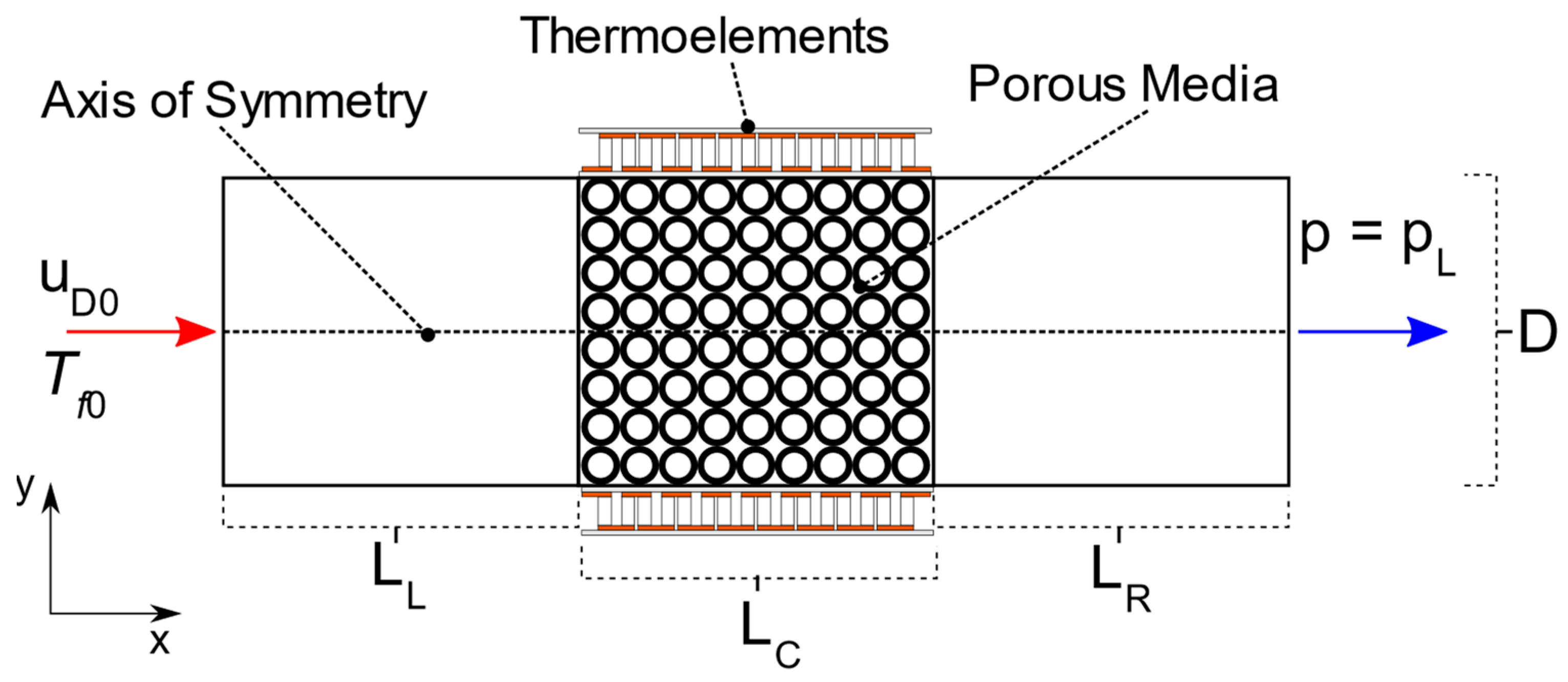
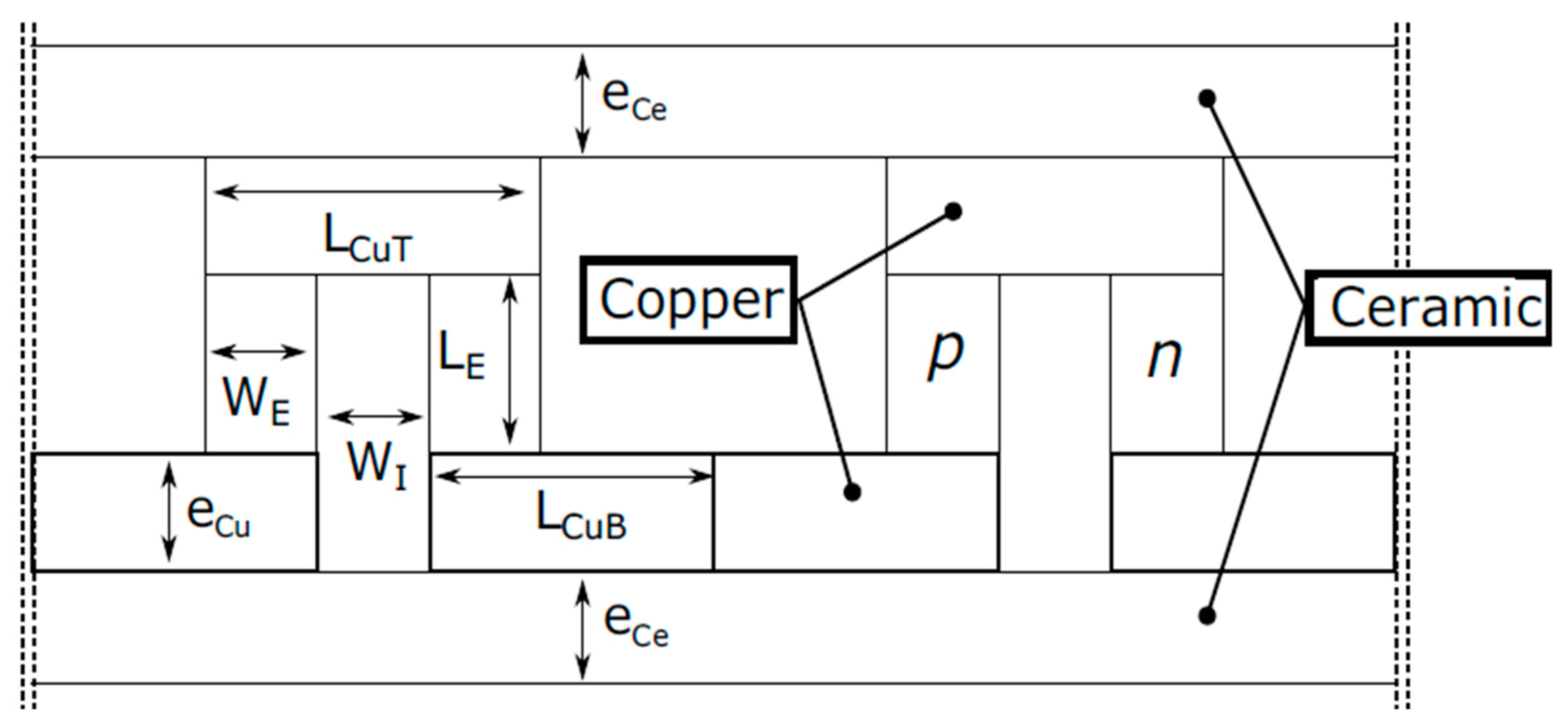

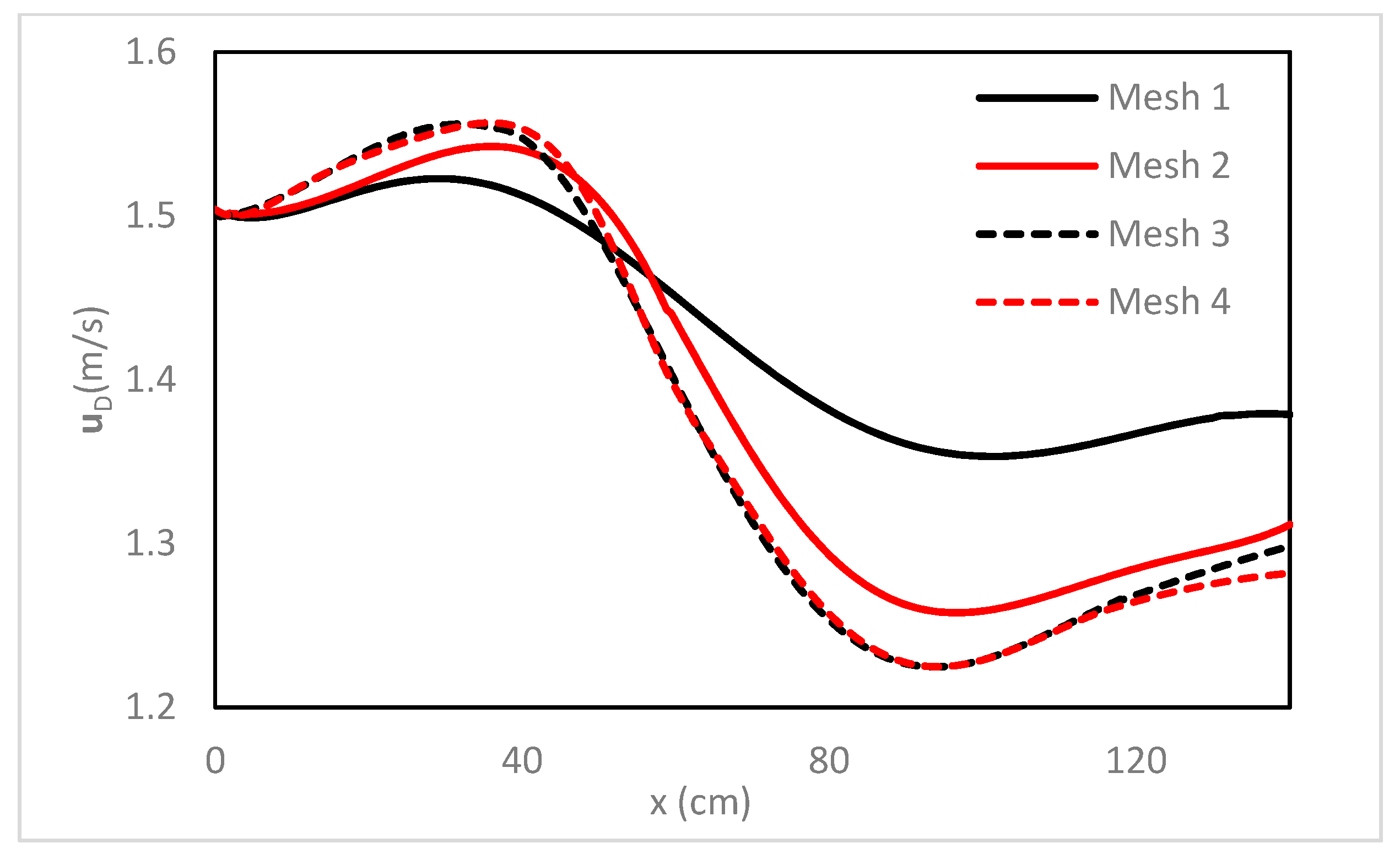
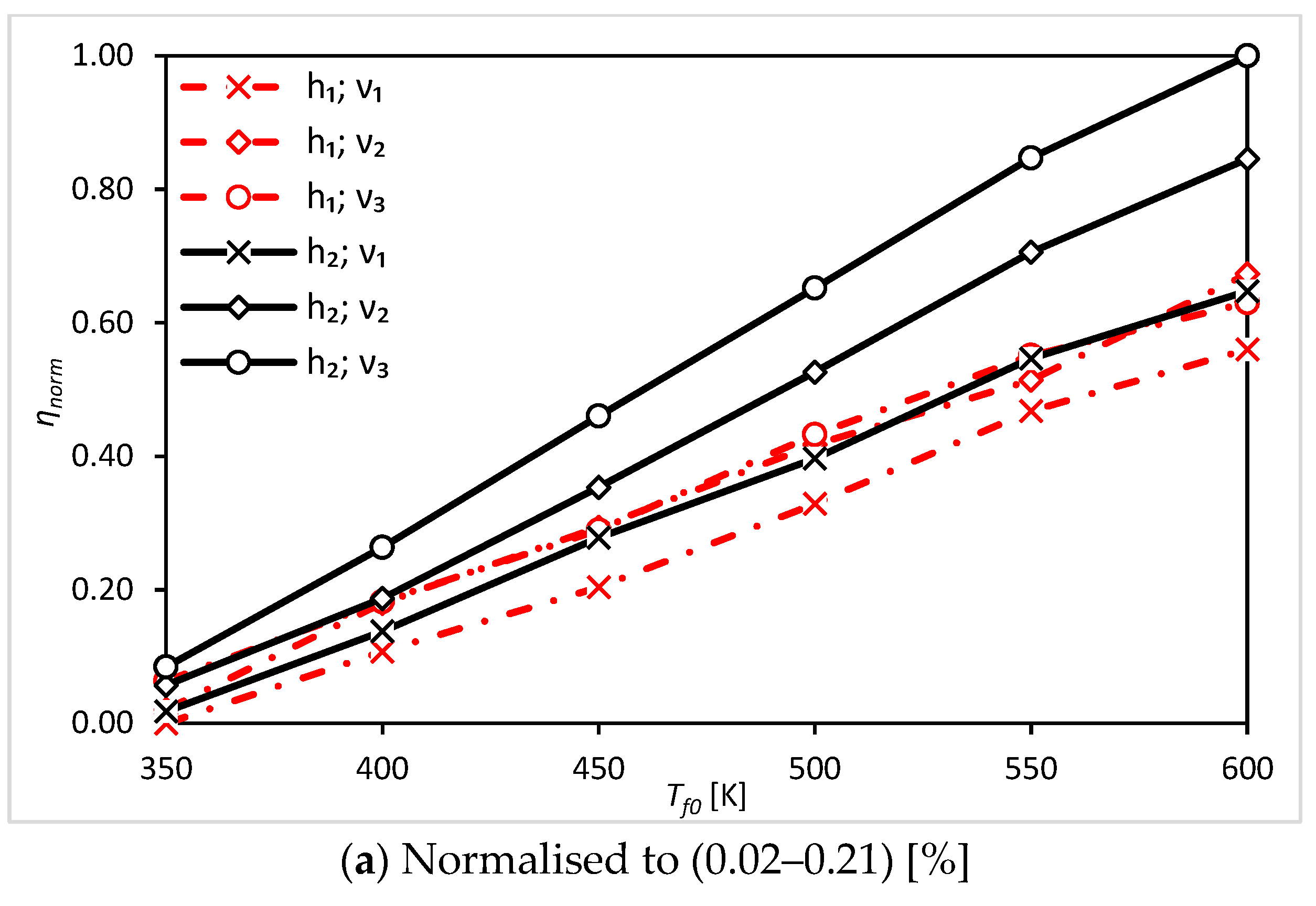

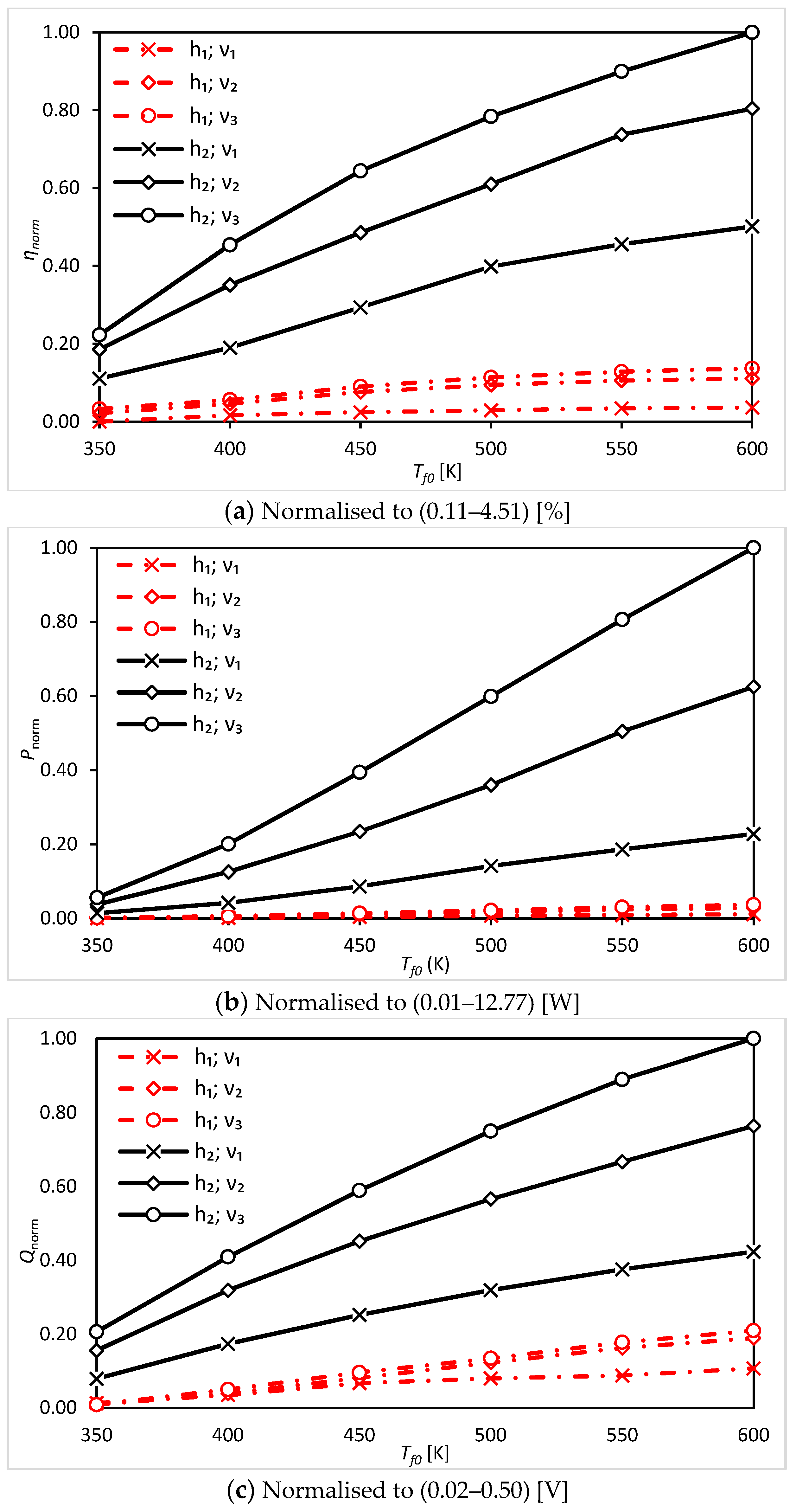
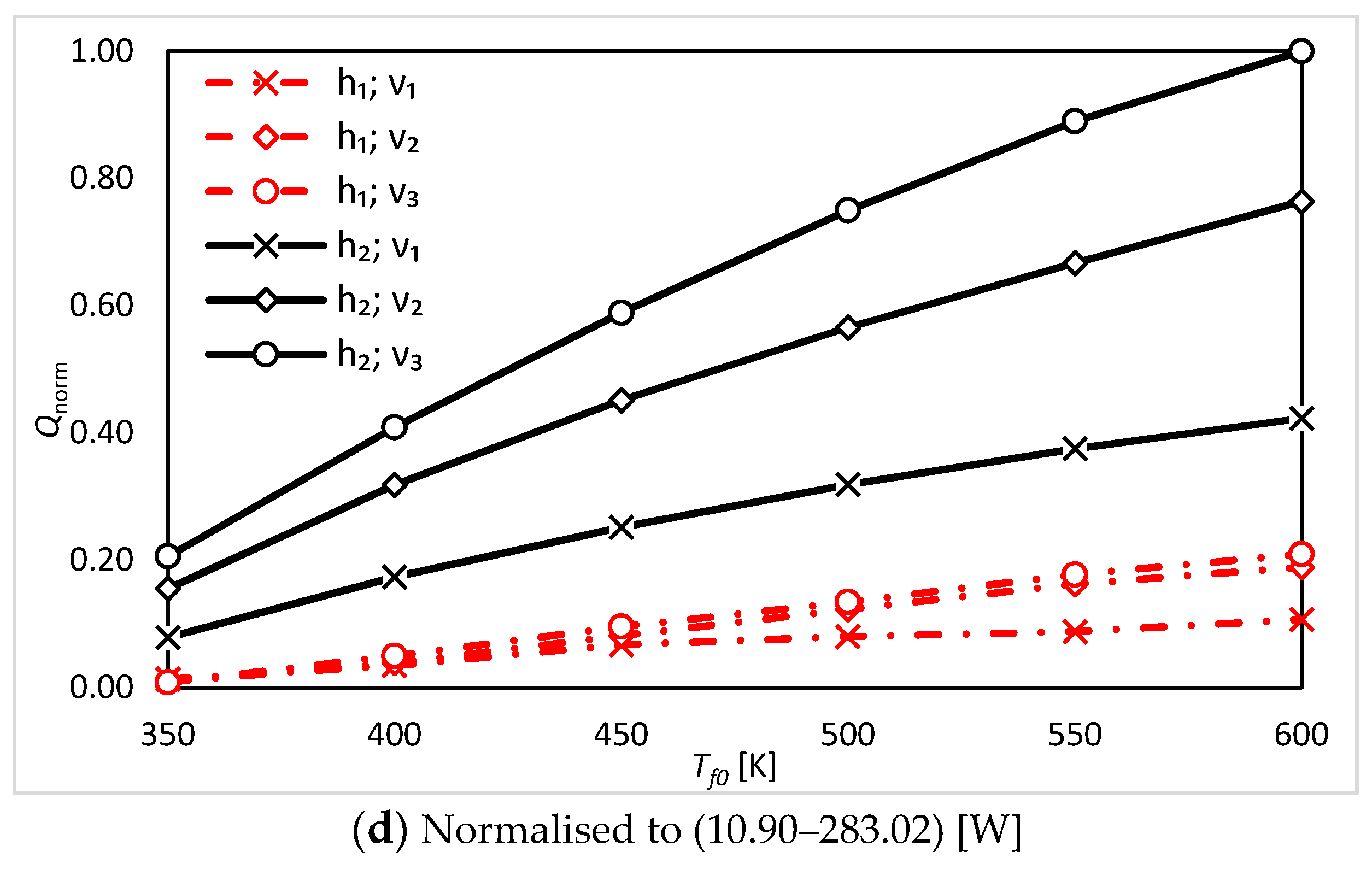
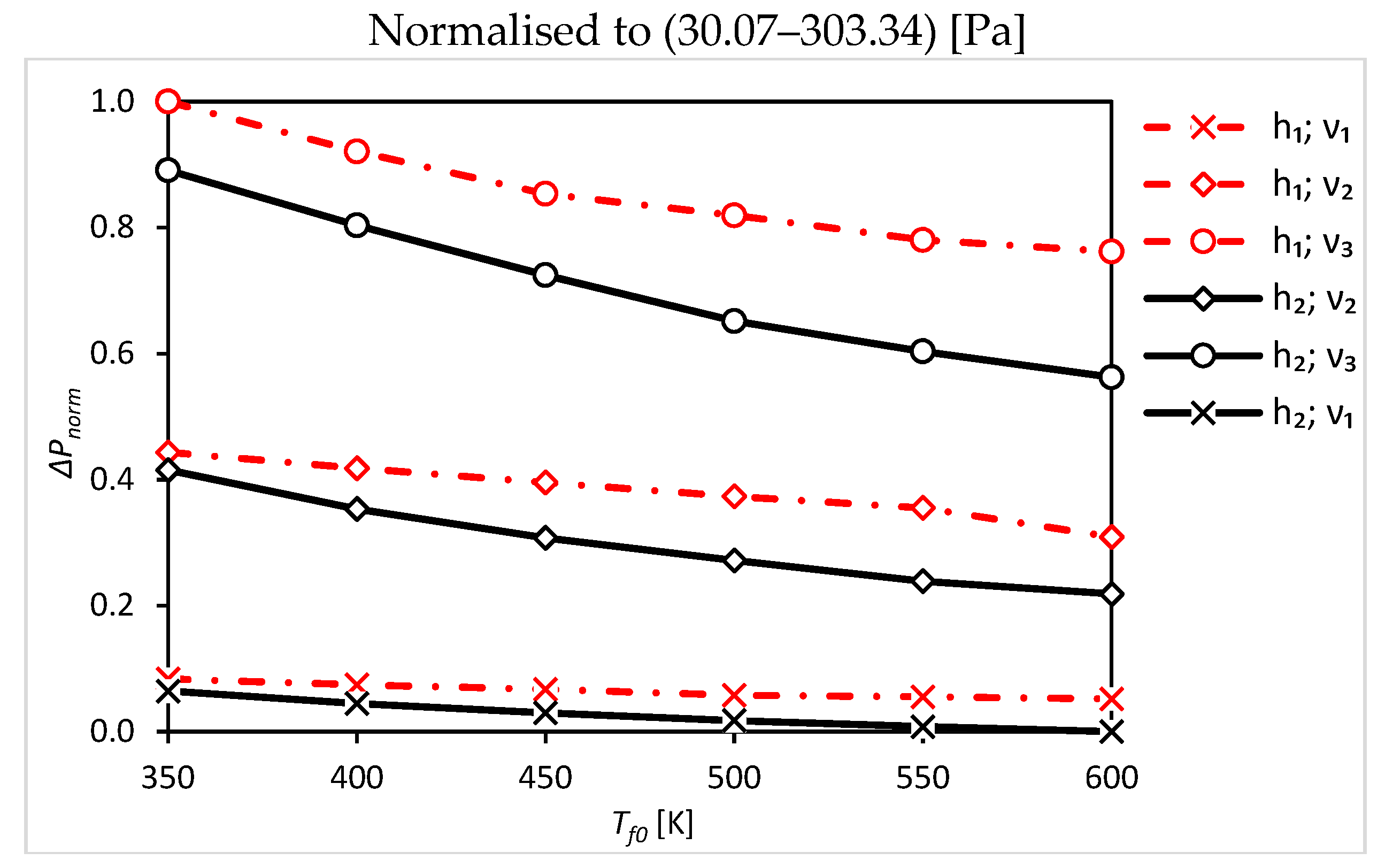





| Symbol | Units | Value |
|---|---|---|
| M | 6.00 × 10−4 | |
| M | 5.00 × 10−4 | |
| M | 1.40 × 10−2 | |
| M | 1.10 × 10−3 | |
| M | 1.95 × 10−3 | |
| M | 1.70 × 10−3 | |
| M | 4.00 × 10−2 | |
| M | 5.00 × 10−2 | |
| M | 4.00 × 10−2 | |
| M | 5.00 × 10−2 | |
| [-] | 16 |
| Property | Mesh 1 | Mesh 2 | Mesh 3 | Mesh 4 |
|---|---|---|---|---|
| Element size (m) | 1.00 × 10−3 | 6.00 × 10−4 | 3.00 × 10−4 | 1.00 × 10−4 |
| Total number of elements | 2975 | 8039 | 32,750 | 291,552 |
Publisher’s Note: MDPI stays neutral with regard to jurisdictional claims in published maps and institutional affiliations. |
© 2022 by the authors. Licensee MDPI, Basel, Switzerland. This article is an open access article distributed under the terms and conditions of the Creative Commons Attribution (CC BY) license (https://creativecommons.org/licenses/by/4.0/).
Share and Cite
Donoso-García, P.; Henríquez-Vargas, L.; Huerta, E. Waste Heat Recovery from Air Using Porous Media and Conversion to Electricity. Energies 2022, 15, 5597. https://doi.org/10.3390/en15155597
Donoso-García P, Henríquez-Vargas L, Huerta E. Waste Heat Recovery from Air Using Porous Media and Conversion to Electricity. Energies. 2022; 15(15):5597. https://doi.org/10.3390/en15155597
Chicago/Turabian StyleDonoso-García, Pablo, Luis Henríquez-Vargas, and Esteban Huerta. 2022. "Waste Heat Recovery from Air Using Porous Media and Conversion to Electricity" Energies 15, no. 15: 5597. https://doi.org/10.3390/en15155597
APA StyleDonoso-García, P., Henríquez-Vargas, L., & Huerta, E. (2022). Waste Heat Recovery from Air Using Porous Media and Conversion to Electricity. Energies, 15(15), 5597. https://doi.org/10.3390/en15155597






